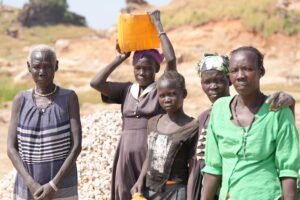By Gabriel Taban
Nestled west of Juba, Jebel Kujur (Korok) offers a stunning view that enhances the capital’s beauty. Once at the outskirts of a smaller Juba, this 684-meter mountain is now surrounded by the city due to post-2005 urban expansion. Known for its unique flora, Jebel Kujur serves as a retreat, a sports hub, and a refreshing escape, providing hikers not only with physical activity but also breathtaking views of Juba from above.
“It’s only when you climb here that you will see the beauty of Juba and its development,” said Augustino Taban, a hiker who patronizes the mountain

Santino Cipriano (carrying a yellow jerrican on his head) poses for a group photo at the quarry site (Photo Gabriel Taban, King News)
Despite its significance to the city, Jebel Kujur faces an existential threat from widespread stone mining and quarrying. Both small-scale and industrial operations encircle the mountain, jeopardizing its natural beauty and integrity. From north to south, east to west, heaps of fractured stones line the roadsides, awaiting purchase by truck operators. This relentless extraction endangers the mountain’s iconic landscape, putting its survival at risk.
“For long, I been breaking stones to meet the needs of my family. Some of these stones we break sometimes stay for two months no client comes to buy, but when they buy for one person, we loan from our sister, and this is how we are surviving in this difficult situation,” said Santina Cipriano, a stone breaker at Rock City
Among those involved in the hazardous stone mining at Jebel Kujur are minors assisting their elders by moving stones downhill. This activity also poses severe risks to nearby residents, as visible signs of erosion suggest an increased threat of landslides. From Nyakuron West to Rock City, red soil and water channels mark the eroded hillsides. Local squatters have already suffered tragic consequences, with two lives lost to falling stones in the past two years.

A section of Jebel Kujur mountain
“Last year, while they were breaking a stone and pushing it down, it missed a house, and there is one area member called Agustino Olia. A stone killed the father, and another elderly person was killed by a flying stone near an area called Iwere on the side heading to Toyota. This mountain has killed many of these our relatives,” Santo Angelo, area chief of Rock City, attested.
At the Eastern side of the highland, some “mountain huts” are visible meters high above the normal ground level.
“These houses get flooded with water from the mountain when it rains, and the snakes are being killed,” Chief Santo added.
The plight of residents in the area and the destruction of the mountain are two different situations that both divulge a looming disaster.
“A stone once injured a child from that area. When it rains, the soil on the mountain becomes loose and can’t hold the stones, and the stones will tumble down and injure people,” said one resident who declines to mention his name
“We are facing a lot of challenges here. When it rains, you see these houses, all of them will collapse because all these places are waterlogs,” said Lucia Patrick, a resident of the area
Despite the looming ordeal of landslides, the government of Central Equatoria State continues to demarcate the lowland areas of the mountain, according to residents of the area.
“Until 2016, this place was barred from demarcation, but they wrote a letter to survey that it should be demarcated, these are the people staying under the mountain,” The area chief Santo said
“When I came here, the place was covered with mud, and I bought it from someone who had settled here already after the mud had been evacuated. That was when I built this place. The reason why we are staying in an undefined area is that we lack demarcation; some engineers came here they brought GPS in that aerial, you see like that house is built,” said an area resident.
Soldiers stationed at the western side of the mountain guarding the heavy machines for stone mining didn’t give the author access to take pictures and conduct interviews.
Efforts to get comments from relevant institutions in Central Equatoria State proved futile after several attempts by the author.

Section of the Jebel Korok



